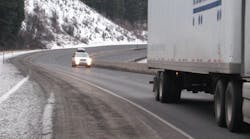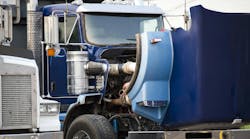We are seeing frigid temperatures in all parts of the country that are now sending many fleets into frenzy. And fuel gelling will be used to support many excuses.
Let’s say the temperature is cold outside, below zero, say minus 2 to minus 15 degrees Fahrenheit. Your trucks will not start, run, or are breaking down on the side of the road. So the fuel supplier gets blamed, or the truck stop where you got your last fill-up. Even your drivers will get blamed when the fuel gels.
So I have asked many people if they’ve ever seen fuel gelling. They all say yes. I ask, “When?” The answer is always, “Well THEY said so.” I ask, “Who is THEY?” I have not as of this day met THEY yet.
True stories
I got a call from a very good friend and fleet operator during Christmas week. He and another fleet were having fuel issues. He said it wasn’t really bad for him because he was on vacation and did not really have to deal with the headaches – only the “B.S.” when he returned. The supplier told him their fuel should be good down to minus 10 degrees.
Then, on Jan. 2, I was on Dave Nemo’s satellite radio show on TMC Tech talk. We wanted to talk about winter fuel issues. So instead of suggesting everything that truckers should do about winterizing their fuel, we wanted input from owner-operators on their experiences and solutions.
Now, there were many comments about filling up at truck stops, and then, five miles down the road, the truck quit. They all had the “aggravation stories” about downtime and freezing until the tow truck got there; about the long wait to find a warm place to get the fuel to flow. The experienced owner-operators said the only answer to fuel gelling in cold weather is to add kerosene to it – and only kerosene.
The point is that gelling is the first thing blamed when there’s a fuel problem in cold weather. But it has to be below negative 15 degrees before fuel even begins to gel. What happens is that ice crystals build up in the fuel line’s 90-degree nipples, or on the fuel filters water-absorbent media. The next stage is that the ice crystals melt by the time someone looks inside the filter, but they leave behind some wax build up. Thing is, it’s not gelling as most describe the problem.
Summary
Here’s what’s really happening. First, ice crystals form from condensation (think of an ice cold glass of beer on a hot summer day). Next, paraffin wax drops out of the fuel. Only then, last and if at all, do you get gelling. The filters are where most of this happens, especially after a cold weekend when the trucks have not run enough to send warm return fuel from the engine to warm the fuel in the tanks.
All of this can be attributed to poor maintenance of the vehicle, storage tanks and truck fuel tanks, as well as a poor understanding of fuel and poor communication with your fuel supplier.
Some believe everything can be solved with pour depressants and additives. But actually there is a point at which you need kerosene. And if you’re buying fuel at a truck stop, it may be treated with additives, but in most cases is not blended with kerosene because kerosene is expensive and most truck stops choose not to blend because fleets do not want to pay for “fuel insurance.”
People way up in the northern U.S. and Canada do not have issues with fuel; they manage the predictable. They have figured how to maintain their fuel below ground, above ground, and most important, in a truck’s fuel tanks – using, yes, kerosene blended in with the fuel. And you’ll hear plenty of stories about fuel gelling. But the issue turns out to be southern fuel traveling to northern points, sitting over a weekend in frigid weather.
So here are a couple of things to consider:
- Use some form of water absorbing additive in the fuel tanks at each PM.
- Vacuum or drain and buildup of condensation that has turned to water at the bottom of the tank at each PM.
- Fuel additives only work until approximately 5 degrees; be cautious.
- Paraffin wax starts to build on filters at minus 5 degrees.
- Blending with kerosene or jet fuel is the only answer.
- In tank fuel heater plumbed through the heater core to the in-tank heater.
- Second choice any electric and or coolant fuel heater.
- DO NOT change micron ratings on fuel filters.
| 10 | Degrees | 10% | Blend/Additive | Additive may be added from the fuel supplier |
| 0 | Degrees | 20% | Blend | Watch 10-day weather forecast |
| -5 | Degrees | 30% | Blend | Watch 10-day weather forecast |
| -10 | Degrees | 30% | Blend | Watch 10-day weather forecast |
| -15 | Degrees | 40% | Blend | Watch 10-day weather forecast |
| -20 | Degrees | 50% | Blend | Watch 10-day weather forecast |
Simple solution for protection
Tanks on Location
Do not rely on the fuel supplier, snake oil salesman, or chemist. When you order or buy fuel, know what you are getting. DO NOT rely on that the order taker to understand winter fuel issues. The term they use is “WINTER BLEND.” When a supplier says it is good for negative 9 degrees or any minus pour point, take the safe path. In most cases they rely on additives to perform. There are too many variables. Play safe; blending with kerosene is the only answer. TELL them what percent of kerosene you want. On the first predictions of extended cold weather, 80% kerosene may have to be ordered to mix with the current tank gallons on hand.
If the supplier insists that his fuel will perform, ask for that in writing and if they will pay for all related cost associated with fuel issue in cold weather? You will get no answer, a deer in the head lights, and they will probably tell you if you want to be safe, use kerosene.
Simply put, control your own destiny, please!
On-the-road purchases
Simple. Follow the same rules, but ask the question, and find out what you are putting in your tanks.
- Kerosene blending is best.
- Additives of choice if there is no kerosene available.
- If traveling from south to north, control your gallons. Each area has its own “winter blend” magic formulas.
So when gelling is blamed for an engine that’s quit running, you better dig. It is rare that that happens. Sludge, wax, water, amoebas and asphaltines are not gelling. The filters are plugging because they’re doing their job – filtering.
Good asset management requires a deeper understanding of the problem and clearer explanation to solve it. Fix the maintenance. Tell the supplier when to stop additives and what percentage of and when you want to blend with kerosene. Take control.



